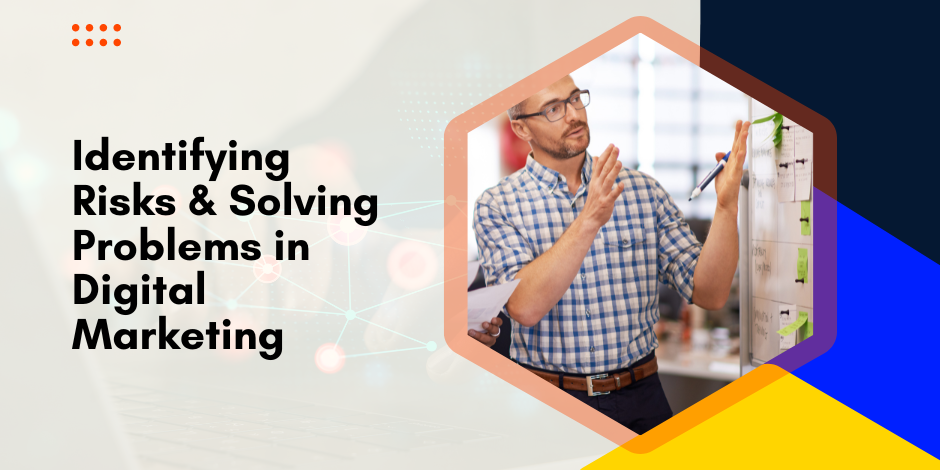Identifying Risks & Solving Problems in Digital Marketing

Stay Informed With Our Weekly Newsletter
Receive crucial updates on the ever-evolving landscape of technology and innovation.
In today’s fast-paced digital landscape, businesses face ever-growing challenges when marketing their products and services online.
With the advancement of technology, organizations must stay ahead of the curve.
Read on to learn more about effectively navigating risks and solving problems in the digital marketing realm.
Solving problems in digital marketing: understanding digital marketing

Digital marketing has become essential to any business in an increasingly connected world.
Businesses, from small startups to multinational corporations, use digital platforms to reach their target audience and drive growth.
Digital marketing encompasses various channels, including search engine optimization (SEO), social media marketing, email marketing, and content marketing.
The digital age demands a strategic and data-driven approach to reach their audience and achieve marketing goals.
Mitigating risks and solving problems in digital marketing is another essential aspect for organizations to thrive in today’s digital economy.
But what do modern organizations need in their ‘solving problems in digital marketing’ toolkit?
The Role of Digital Marketing in Today’s Business World
Digital marketing has revolutionized how businesses communicate, connect, and engage with their audience.
It provides an opportunity to reach specific demographics, gather valuable customer insights, and measure the effectiveness of marketing campaigns.
By leveraging digital platforms, businesses can expand their reach, improve brand visibility, and drive customer engagement.
Components of a successful digital marketing strategy
A successful digital marketing strategy involves harmonizing key components to achieve business objectives.
These components include:
- Clear goals and objectives: Define what you hope to achieve with your digital marketing efforts, whether it’s increasing brand awareness, generating leads, or driving conversions.
- Target audience analysis: Identify your target audience’s demographics, preferences, and online behavior to tailor your marketing messages effectively.
- Strategic content creation: Develop high-quality, engaging content that reaches your target audience and drives them to take action.
- Effective channel selection: Choose the right digital platforms and channels to connect with your audience where they are most active and receptive to your message.
- Data-driven decision-making: Utilise analytics and key performance indicators (KPIs) to measure the success of your campaigns and make informed marketing decisions.
In addition to these key components, organizations must stay updated with the latest technologies and trends in the digital marketing landscape.
As technology evolves, new opportunities and challenges arise.
Businesses must also consider the importance of user experience in their digital marketing efforts.
A seamless and intuitive user experience across all digital touchpoints can significantly impact customer satisfaction and loyalty.
From a well-designed website to a user-friendly mobile app, customer interaction with a brand online contributes to their overall perception and experience.
Ultimately, a good digital marketing strategy requires a deep understanding of the target audience, a data-driven approach, and the ability to adapt to the ever-evolving digital landscape.
By embracing new technologies, businesses can effectively navigate the digital marketing landscape and drive sustainable growth.
Identifying common risks in digital marketing

While digital marketing offers numerous business opportunities, it comes with its fair share of risks.
Understanding and addressing these risks is crucial to ensure the effectiveness and success of your digital marketing efforts.
The danger of ignoring SEO
SEO drives organic traffic to your website.
Neglecting SEO best practices can result in poor website visibility, low search rankings, and missed opportunities to reach potential customers.
Solving problems in digital marketing involves investing time and resources into optimizing their websites for search engines to improve their online presence and attract relevant organic traffic.
Social media pitfalls to avoid
Social media offers organizations various opportunities to connect and engage with their audience.
However, it’s essential to approach social media marketing with strategy.
Failing to maintain a consistent brand presence, engaging inconsistently with followers, or using an inappropriate tone can significantly impact brand reputation and customer perception.
The risks of email marketing
Email marketing is a powerful tool for organizations to communicate with their audience directly.
However, it’s important to be mindful of spamming practices and ensure compliance with data protection regulations.
Failure to do so can result in damaged brand reputation, legal implications, and a loss of trust from your subscribers.
Strategies for solving digital marketing problems
It’s crucial to develop effective problem-solving strategies to overcome the challenges faced in digital marketing.
Organizations can navigate the digital landscape and achieve their marketing goals by implementing these strategies.
Overcoming SEO challenges
SEO can be complex, but businesses can overcome common challenges with the right approach.
Key strategies for overcoming SEO challenges include staying up-to-date with algorithm changes, conducting thorough keyword research, optimizing website speed and mobile-friendliness, and creating valuable content.
Navigating social media issues
Solving problems in digital marketing means navigating social media issues such as negative feedback, negative reviews, or customer complaints.
It’s crucial to respond promptly, professionally, and empathetically to such issues, addressing them transparently and seeking resolutions.
Consistent monitoring, engagement, and proactive content creation are essential to maintain a positive brand image on social media.
Addressing email marketing concerns
To address concerns related to email marketing, businesses must ensure they have explicit consent from subscribers, offer valuable and relevant content, and facilitate easy opt-out options.
Implementing personalization techniques, segmenting your email lists, and testing different email formats can help address concerns and improve email marketing performance.
Tools and techniques for effective problem-solving in digital marketing
Solving problems in digital marketing means utilizing the right tools and techniques.
Streamlining problem identification and resolution processes ensures optimal performance and efficiency.
Utilising analytics for problem identification and resolution
Analytics platforms like Google Analytics provide valuable insights into website performance, user behavior, and campaign effectiveness.
By leveraging these tools, businesses can identify potential issues and make data-driven decisions to optimize their digital marketing efforts.
The role of automation in problem-solving
Automation tools can significantly enhance efficiency and effectiveness in digital marketing.
From automating emails and social media posts to implementing chatbots for customer support, businesses can save time and resources while maintaining consistent communication and engagement with their audience.
Preparing for the future of digital marketing

Solving problems in digital marketing is pivotal in a rapidly evolving landscape.
Organizations must adapt their strategies to stay ahead of the competition and meet changing customer expectations.
Emerging trends and their potential risks
Businesses need to stay informed about emerging trends and technologies that can impact the digital marketing landscape.
From artificial intelligence and voice search to immersive experiences, understanding these trends allows businesses to capitalize on opportunities while mitigating potential risks.
Adapting your strategy for future success
As new technologies and platforms emerge, organizations must adapt their digital marketing strategies agile.
Mitigating risks and solving problems in digital marketing is fundamental in the digital economy.
Regularly assess your marketing goals, explore new channels, and optimize your campaigns to ensure your organization stays relevant and successful in the ever-changing digital landscape.
Conclusion
Navigating the risks and solving problems in digital marketing requires a comprehensive approach.
By understanding the digital marketing landscape, pinpointing risks, deploying effective problem-solving tactics, using appropriate tools and methods, and planning for future developments, organizations can optimize their digital marketing initiatives and reach their targeted results.
Are you ready to launch your career in digital marketing?
If so, we encourage you to explore the Institute of Data’s Digital Marketing & Artificial Intelligence Program.
Alternatively, we invite you to book a complimentary call with a member of our team to discuss the Digital Marketing program in more detail.




